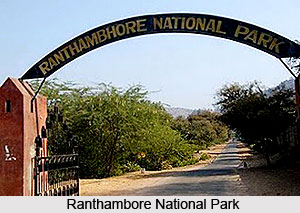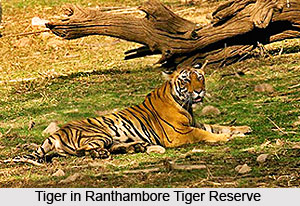 History of Ranthambore Tiger Reserve says that Ranthambore Tiger Reserve was among the first nine Tiger Reserves declared in 1973 at the launch of Project Tiger in India. It comprised the former Sawai Madhopur Wildlife Sanctuary of around 392.5 sq km constituted in 1955. Ranthambore National Park with an area of 274.5 sq km. was constituted within the Tiger Reserve in 1980. The National Park area was being managed as the core and the rest as buffer until in 1992, Kela Devi Sanctuary having area of 674 sq km of Protected Forest (constituted in 1983), Sawai Man Singh Sanctuary with an area of 127 sq km (constituted in 1984). Some other forest areas were also added to this reserve.
History of Ranthambore Tiger Reserve says that Ranthambore Tiger Reserve was among the first nine Tiger Reserves declared in 1973 at the launch of Project Tiger in India. It comprised the former Sawai Madhopur Wildlife Sanctuary of around 392.5 sq km constituted in 1955. Ranthambore National Park with an area of 274.5 sq km. was constituted within the Tiger Reserve in 1980. The National Park area was being managed as the core and the rest as buffer until in 1992, Kela Devi Sanctuary having area of 674 sq km of Protected Forest (constituted in 1983), Sawai Man Singh Sanctuary with an area of 127 sq km (constituted in 1984). Some other forest areas were also added to this reserve.
History of Ranthambore Tiger Reserve states that by the end of the first quarter of the 20th century, the need for conservation of forests and wildlife was largely felt throughout the country. The population was growing rapidly and the forests were coming under pressure. In Ranthambore, the system of `royalty permits` for commercial felling (mainly for charcoal and firewood) of entire blocks of forests was taking its toll. In 1939 the Jaipur Forest Act was enacted. The Rajasthan Forest Act was enacted in 1953, giving these forests some legal protection. In 1955, these forests were declared as Sawai Madhopur Sanctuary and the practice of sale of forest produce through royalty permits came to an end. This was when the forests of Ranthambore received their first real protection. However, legal hunting continued unabated till 1973 and by then the tiger population was almost totally decimated.

History of Ranthambore Tiger Reserve also suggests that in 1973 a part of this Sawai Madhopur sanctuary came under the conservation scheme Project Tiger in India. At that time there were 16 villages inside the sanctuary but between 1976 and 1979, 12 of these villages were shifted outside the sanctuary. In 1980, in order to give greater protection to the forests, an area of nearly 282.03 sq km of the inner part of Sawai Madhopur Sanctuary was declared as national park. Since then the state government stopped collection of any forest produce from sanctuary and national parks. In the year 1983, 647 sq km of forests lying to the north of national park were declared as the Kela Devi Sanctuary and included in the Tiger Project. Similarly, in 1984, 130 square km of forests lying to the south of the Ranthambore National Park were declared as Sawai Man Singh Sanctuary and included in the Tiger Project.
During the 1970s, tiger sightings were extremely rare in Ranthambore but by the mid and late 1980s, as a result of the decade long protection given to the forests, Ranthambore became the best place in the world for seeing wild tigers. Since 1992, the tiger population has gradually recovered and in 2002 the Park boasted of nearly 40 tigers, a density of nearly 10 tigers per 100 square km, which is one of the highest in the world. In 2005, Rajasthan state government and the Government of India set up high powered committees to look into the state of Ranthambore and to suggest measures to improve the situation.



















